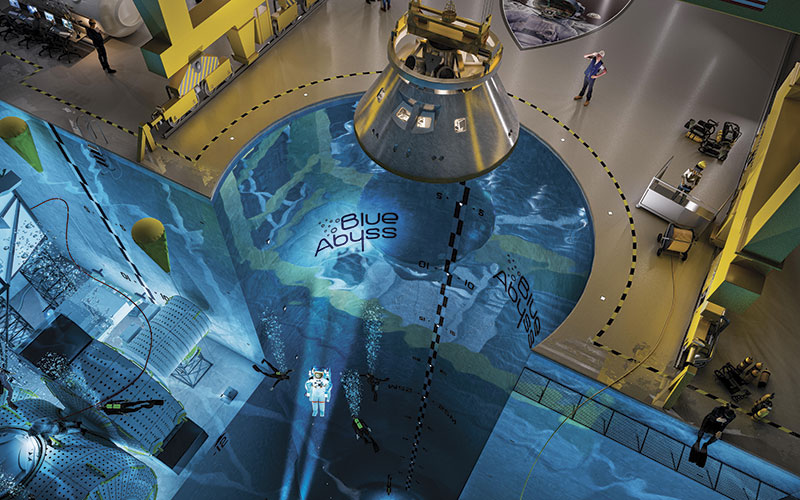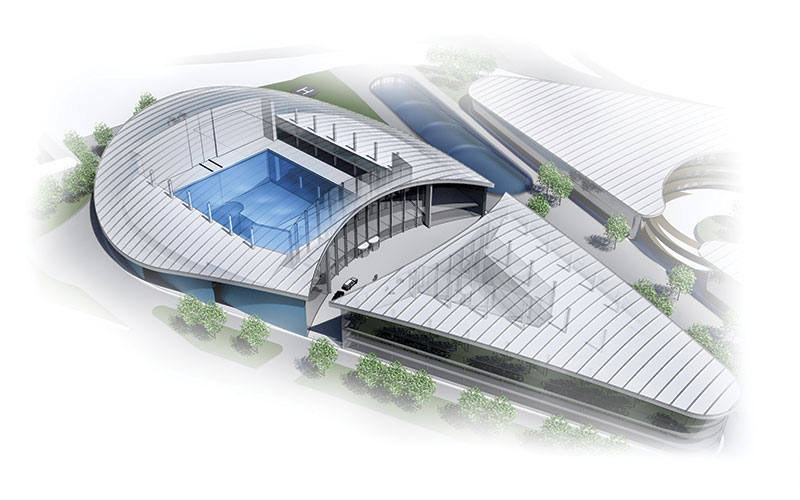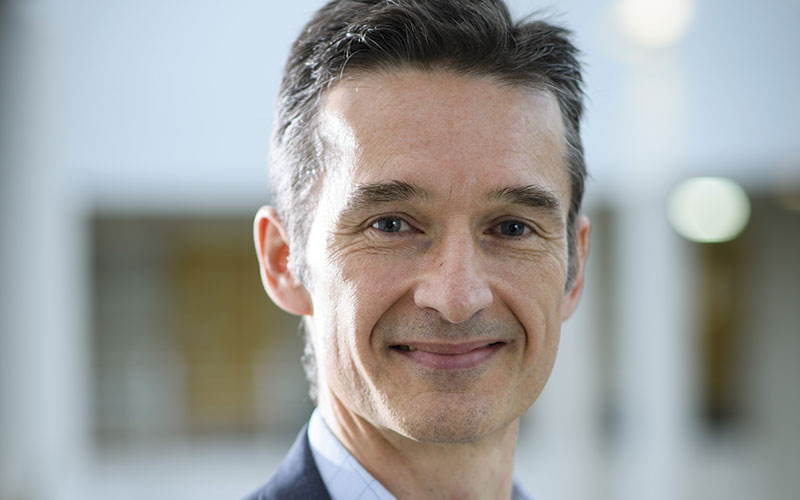We talk to Professor Simon Evetts, Space Operations Director at Blue Abyss – a cutting-edge deep-sea and space extreme environment research centre.

Of all the impressive new high-tech research centres that are popping up around the world, the one that will occupy the old RAF Henlow site in the heart of the Bedfordshire countryside takes some beating.
Called Blue Abyss, it will be a training, research and development centre for exploring human and robotic reactions to the extreme environment of deep water and, by proxy, the weightless and airless conditions of space. Due to be operational by 2020, the centre hopes to draw work not just from the burgeoning commercial spaceflight sector, but also from offshore exploration and healthcare research.
The eye-catching centrepiece of Blue Abyss will be a 50-metre by 40-metre pool with multi-stepped depths. The platform at a depth of 12 metres will be able to host a mock section of space craft for astronaut training, while the deepest level will reach down to 50 metres, where the pressure will be five times the level at the surface. Overall, the pool will hold 42,000 cubic metres of water, making it, in terms of volume, the biggest facility of its kind in the world.
It will also have a sliding roof to allow training capsules to be winched into the pool, and it will be equipped with hypobaric and hyperbaric chambers, a microgravity suite, and a high-G centrifuge. In a nod to its intended status as a worldwide attraction, it will also have an on-site hotel. Discussions are already underway for developing similar centres in the US and Middle East.
 Ambitious project
Ambitious project

Blue Abyss is the vision of John Vickers, a former soldier and management consultant. Raising the money for such a project is one thing, but his ambitions for the centre also rest on attracting top scientific talent, and among those he has signed up is Professor Simon Evetts.
Simon has a long and distinguished history in space biomedicine, so what was it that attracted him to the role of Space Operations Director for the project? “I had been working for the European Astronaut Centre in Cologne for the best part of a decade on astronaut health,” he says, “and I was looking for the opportunity to come back to the UK and continue working in the field of human space flight. When I left 10 years ago, there wasn’t really much going on, but when I heard from John Vickers, well, that brought me back.”
For the past three years, Simon has been busy defining the space element of the Blue Abyss proposition, and helping to develop the blueprints for the services and facilities that will enable agencies and companies to prepare people for travelling into space. He has also been exploring academic partnerships with a number of key universities, including Imperial College London and the Massachusetts Institute of Technology. But Blue Abyss is also reaching out beyond academia, and wants to connect with multiple sectors and disciplines. “We intend to be a melting pot,” he says, “bringing in industry and research teams for sectors such as energy, defence, space and healthcare. We will help innovation happen.”
Life sciences
Once the centre opens and finds its feet, the part of his job that focuses on the facilities for space training will recede
(“we will bring in astronauts who know much more about space than I do”), to be replaced by more in the way of pure research. “The research and development fields we want to pursue will encompass more or less anything related to extreme environments for human beings and robots, and even the machine-human interface,” he says.
While he can’t be more specific on the details of the research just yet, Simon is clear-eyed about what he wants it to achieve: “My research background is in space medicine and life sciences, and along the lines of understanding the de-conditioning processes that happen in the body, and how we rehabilitate or even prevent those processes. In space, people de-condition something like seven times faster than they do on Earth. It’s not just our muscles, but lots of other physiological aspects. This is very closely related to the de-conditioning processes we encounter with ageing and sedentary lifestyles. If we can understand more about those de-conditioning factors, we are in a much better position to tackle them.”
All about Simon


-
Ran the multidisciplinary Medical Projects and Technology Unit at the European Astronaut Centre in Cologne, Germany.
-
Developed space biomedicine at Wyle – NASA’s main astronautics services provider.
-
Visiting senior lecturer at King’s College London; visiting professor at Northumbria University.
-
Co-founder of the UK Space Life and Biomedical Sciences Association and the UK Space Environments Association.
Weightless treatments
He continues: “In this way, we want as much of the research and development we do here at Blue Abyss into the effects of the space environment on the human body to translate outwards into healthcare on Earth.”
To this end he wants to ensure that the centre has plenty of capacity to suspend human bodies in different ways and to replicate as far as possible the weightlessness that takes muscles and limbs out of their normal operational conditions. Also involved in this aspect of Blue Abyss’s work is Professor Walter Kuehnegger, who prepared astronauts to walk on the moon for NASA’s Apollo programme. “He really understands locomotion in a low-G environment,” says Simon, “and has translated that from space to healthcare as an orthopaedic surgeon, and in providing new treatment for people with locomotive conditions.”
But as the personnel and the ideas continue to solidify, the main job remains to get Blue Abyss open. “It will take a couple of years to get it built, and over the next 12 months we will be defining much more closely what we want in terms of research. It has been a very exciting first three years. Now I am looking forward to the next three years and beyond.”
